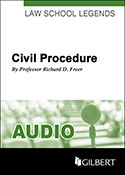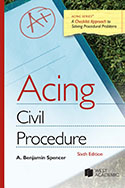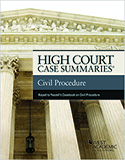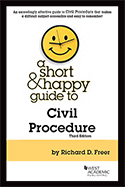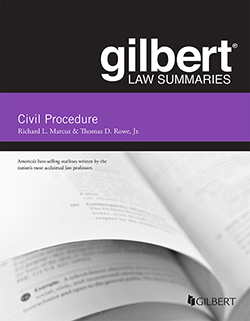
Gilbert Law Summary on Civil Procedure
Authors:
Marcus, Richard L. / Rowe Jr., Thomas D.
Edition:
18th
Copyright Date:
2017
20 chapters
have results for gilberts civil
Chapter Nine. Trial 19 results (showing 5 best matches)
- When a statute provides a civil penalty for violation ( , a certain amount per day of violation), that is sufficient to create a right to jury trial in an action for a civil penalty. [ —action for civil penalties for violation of Clean Water Act]
- Since the United States Constitution does not require states to provide jury trials at all, the number of jurors in state-court civil trials depends entirely on state law. Many states have long used juries with fewer than 12 members in civil cases, particularly when the amount in controversy is small.
- The minimum number of jurors required by the Seventh Amendment in federal-court civil cases has not been finally resolved. Local district rules providing for juries in civil cases have been upheld—on the rationale that the outcome of the verdict is not likely to be affected substantially by the number of jurors (at least as between 12 and 6). [
- Unlike many other Bill of Rights guarantees, the Seventh Amendment right to trial by jury in civil cases has not been held “incorporated” into the Due Process Clause of the Fourteenth Amendment. Hence, the federal Constitution does not assure such a right in state-court proceedings. [ The Seventh Amendment remains inapplicable to civil cases in state court, although the Supreme Court has noted that the cases establishing this rule were decided long before the Court adopted its current “selective-incorporation” approach. [
- : State-court civil action based on claims under Federal Employers Liability Act. [
- Open Chapter
Chapter One. Personal Jurisdiction and Related Matters 6 results (showing 5 best matches)
- Gulf Oil Corp. v. Gilbert
- The same venue provisions apply to all civil actions in federal district court. [
- Most civil-procedure courses include consideration of where a suit may be brought. In a country the size of the United States, that can prove very important. Those issues raise questions of personal jurisdiction (
- in which suit may be brought. In the federal judicial system, venue “refers to the geographic specification of the proper court or courts for the litigation of a civil action that is within the subject-matter jurisdiction of the district courts in general, and does not refer to any grant or restriction of subject-matter jurisdiction.” [
- —“the proper venue for a civil action shall be determined without regard to whether the action is local or transitory in nature”] Accordingly, venue cannot be defeated on the ground that the suit should be classified as a “local action.”
- Open Chapter
Chapter Ten. Appeal 10 results (showing 5 best matches)
- Review of civil decisions of the courts of appeals is by the Supreme Court of Texas, which exercises civil jurisdiction only. (Criminal appeals go to the Court of Criminal Appeals, a court of last resort, directly from trial courts in capital cases and from the courts of appeals in other cases.)
- The right to appeal in civil matters is a creature of statute.
- Legislation in every state creates a civil appellate jurisdiction in some court of the state.
- There is, likewise, a statutory right of appeal in civil proceedings in federal district court. [
- In California, the trial court of general jurisdiction is the superior court, which also exercises appellate jurisdiction with regard to “limited civil cases,” suits formerly heard by the municipal courts. [
- Open Chapter
Capsule Summary 20 results (showing 5 best matches)
- civil
- In federal courts, the right to a jury trial in civil actions at law is derived from the , the right to a jury trial in civil cases is
- by either due process or the Seventh Amendment. In federal civil cases, there must be at least six. The Sixth Amendment
- federal civil rights
- coincided with adoption of the Federal Rules of Civil Procedure. Thus, at the same time federal courts increased
- Open Chapter
Chapter Two. Subject-Matter Jurisdiction of the Federal Courts 8 results (showing 5 best matches)
- There are two main constitutional headings of federal-court civil jurisdiction: diversity jurisdiction and federal-question jurisdiction. jurisdiction is authorized when a claim arises under federal law. (A third significant basis for federal-court civil jurisdiction, cases involving the federal government or its agencies or officers, is not covered in most first-year civil-procedure courses.)
- after the Civil War. The statute used language very similar to that in the Constitution, granting the federal courts jurisdiction to hear “all civil actions arising under the Constitution, laws, or treaties of the United States.”
- Most civil cases brought in federal courts are brought under one of two subject-matter jurisdiction statutes: the diversity statute [
- A civil action in which any party asserts a claim, including a counterclaim, for relief under any Act of Congress relating to patents, plant-variety protection, or copyrights may be removed even though a federal statute provides that state courts have no jurisdiction over such claims. [28 U.S.C. §§ 1338(a), 1454]
- In certain cases, special removal statutes apply. For example, when a state-court defendant in a civil or criminal case cannot adequately protect her
- Open Chapter
Chapter Eight. Managerial Judging, Settlement Promotion, and Arbitration 10 results (showing 5 best matches)
- any civil action
- , federal district-court judges have an expanded pretrial role in the control and development of civil cases.
- In state courts where arbitration is authorized, eligibility may turn on the amount claimed, as in federal courts. In California superior courts, for example, all civil actions in which the amount in controversy, in the opinion of the court, will not exceed $50,000 are subject to arbitration. [
- 1. Federal Rule of Civil Procedure 68
- 1. Until recently, pretrial conference and settlement promotion were considered beyond the scope of a first-year course, and they still are more likely to be given intense attention in an advanced course on complex litigation. Nevertheless, they have increasingly been covered in the basic first-year civil procedure course. Moreover, they may play an increasing role in examinations involving challenges to actions by judges that fall outside the traditional realm of judicial activity. In connection with such examination questions, there are two basic questions to be asked:
- Open Chapter
Approach to Exams 1 result
- Examination questions on civil procedure can concern a wide range of issues. The issues that you are most likely to encounter are discussed below and can be analyzed in the following sequence. (Note that these issues are discussed in greater detail in the Key Exam Issues section at the beginning of each chapter.)
- Open Chapter
Title Page 1 result
Chapter Four. Pleadings and Motion Practice 8 results (showing 5 best matches)
- In most jurisdictions, a civil action is commenced by the filing of the plaintiff’s complaint. [
- a) Civil Rights Claims
- The plaintiff begins a civil action by filing in a court of appropriate jurisdiction a
- was introduced in the mid-19th century to require only that a plaintiff set forth the facts underlying the dispute. Many states adopted that form of pleading, and a number still use it. Second, the Federal Rules of Civil Procedure introduced what has been called
- : A federal statute prohibits states from violating a person’s constitutional rights. Plaintiff filed a complaint alleging that the manager of Defendant’s store had an arrangement with the local police under which the police would assist the store in refusing service to African Americans at its lunch counter. The complaint was held sufficient to state a claim for violation of Plaintiff’s civil rights under federal statutes, since even if the store itself was not governed by the statute, the police were so governed and the complaint alleged concerted action between Defendant (through its manager) and the police. [
- Open Chapter
Chapter Six. Discovery 6 results (showing 5 best matches)
- Privileged material is universally excluded from obligatory disclosure through discovery. Most civil-procedure courses do not examine any privilege in detail, except the attorney-client privilege, which will be the main focus here. It is the oldest and most frequently invoked privilege.
- b. Civil Contempt
- The contempt sanction may be civil, and thus coercive in effect (
- An order of civil contempt is not final and hence is not generally appealable until final judgment is entered. [ : Sometimes the distinction between civil and criminal contempt is difficult to discern. [
- Civil litigants are entitled to conduct their own private investigation of the facts and are not obliged to use the discovery process to secure information. [
- Open Chapter
Half Title 1 result
- Many civil judgments are nonfinal in the sense that they are subject to modification (
- For cases involving federal employment-discrimination claims, Congress, in the Civil Rights Act of 1991, changed the ruling of
- : White firefighters, who had not been parties to a prior litigation between a city and civil rights claimants that resulted in consent decrees establishing minority hiring and promotion goals, were not precluded from bringing a discrimination suit against the city for promotion decisions it made under the decree. It was immaterial whether the white firefighters could have intervened in the first litigation; the burden of joining additional parties to secure binding effect against them is on those already parties. [
- Open Chapter
Exam Questions and Answers 2 results
- 1. Assuming that Utah has state rules modeled on the Federal Rules of Civil Procedure in relevant respects, by what procedure may Mitsui Machinery and Mitsui-American challenge the attachment?
- Since the action is in federal court, the Federal Rules of Civil Procedure apply. There is no demurrer under the Federal Rules, so the question becomes what kind of motion should be prepared.
- Open Chapter
Summary of Contents 1 result
Index 3 results
Chapter Five. Parties 4 results
- , if the case relies on diversity jurisdiction, the jurisdictional amount is the same as in any other civil action (more than $75,000).
- , service of process is the same as in any other civil action—
- In the ordinary civil action, notice has the effect of making the notified person a
- , venue is the same as in any other civil action—
- Open Chapter
Chapter Three. Relation Between State and Federal Law 14 results (showing 5 best matches)
- Federal Rule of Civil Procedure
- ], originally adopted in 1789. In its present form the Act provides, “The laws of the several states, except where the Constitution or treaties of the United States or Acts of Congress otherwise require or provide, shall be regarded as rules of decision in civil actions in the courts of the United States, in cases where they apply.”
- test. If that test were applied broadly, almost any procedural rule could qualify as substantive because (especially if disobeyed) it could affect the outcome of a case. In fact, some cases applying the test appeared to raise doubts about whether many Federal Rules of Civil Procedure could govern when state law differed, but the Supreme Court has subsequently drawn back from the most far-reaching readings of
- . However, when Federal Rules of Civil Procedure arguably conflicted with the law that would apply in state courts, a parallel but mostly independent line of cases developed. The Court sorted out the different law-choice
- Federal Rule of Civil Procedure 4(d)(1)
- Open Chapter
- Publication Date: July 25th, 2017
- ISBN: 9781683281016
- Subject: Civil Procedure
- Series: Gilbert Law Summaries
- Type: Outlines
- Description: The topics discussed in this law-school study outline include territorial (personal) jurisdiction (including venue and forum non conveniens) and subject-matter jurisdiction (covering diversity jurisdiction, federal-question jurisdiction, removal and supplemental jurisdiction). The Summary provides an accessible explanation of the Erie doctrine and federal common law. It introduces contemporary doctrine on pleadings (including counterclaims, crossclaims, amendments and supplemental pleadings) and joinder of parties (including joinder and class actions). Coverage also includes discovery (including the 2015 rule amendments regarding devices, scope, sanctions and discovery conferences). Separate chapters address summary judgment, pretrial conferences, settlement-promotion devices, and settlements. The trial chapter covers the right to jury trial, trial motions, jury instruction and arguments, and post-verdict motions. There are also chapters on appeals and preclusion (both claim and issue preclusion). The Summary begins with an extensive Capsule Summary of all the topics covered, and also includes Review Questions keyed to the outline's coverage, and sample essay questions and answers. Throughout the outline, there are also Exam Tips and charts to summarize and explain the material.
